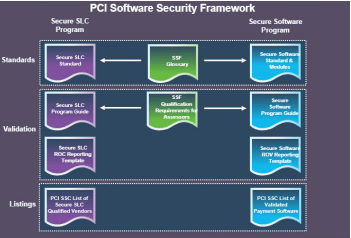PCI ssf

PCI-SSF
Today, with the advancement of technology and the digital revolution, almost
everything we tend to do with the employment of the internet, and also the
payment strategies have been modified in digital payment strategies.
Internet banking and banking cards are main transaction method that takes place
via online. With the advancement of recent modern payment methods, the
traditional methods of securing the software that promotes payments ought to
additionally develop.
PCI SSF is the result of all this need an array of developing phases and efforts in this direction.
Developing phase-PCI-DSS &PCI SSF
With all of these Data failures and data, theft is sadly common and negatively
influences all payments parties in several directions—from retailers to consumers
to banks—so the necessity for PCI compliance is that the greatest ever.
PCI standards for compliance are developed and conducted by the PCI Security
Standards Council and is directed by credit card corporations to assist make sure
the security of credit card transactions within the payments business.
PCI SSC initiated the Payment Application Data Security Standards (PA DSS) in the
year 2008 with the insight of securing payment applications. PA DSS helps
payment application vendors promote secure payment applications.
With growing times, the number of payment strategies started spreading, and for this to
assist the current security requirement of the payment world, PCI SSC has revealed
the PCI DSS (Payment Card Industry Data Security Standard) is a security standard
Which is developed and supported by the PCI Council and Its purpose is to assist secure and
defend the complete payment card ecosphere.
PA DSS basic and Restraints

The Payment Card Industry Data Security Standard (PCI DSS) is an information
security standard for organizations that hold branded credit cards from the major
card schemes.
The PCI Standard is directed by the card brands but executed by the Payment
Card Industry Security Standards Council. The standard was created to boost
controls and supervise cardholder data to bring down credit card fraud.
Validation of compliance is performed annually or quarterly, by a technique
appropriate to the degree of transactions handled
• Self-Assessment Questionnaire (SAQ) — smaller volumes
• external Qualified Security Assessor (QSA) — moderate volumes; associated
an Attestation on Compliance (AOC)
• firm-specific Internal Security Assessor (ISA) — larger volumes; associated
issuing a Report on Compliance (ROC)
The objectives of each were approximately similar to create an additional level of
protection for card issuers by securing that merchants meet the lowest levels of
security when they store, process, and transmit cardholder data. To examine the
integration problems among the existing standards, the combined effort made by
the principal credit card organizations yielded in the release of version 1.0 of PCI
DSS in December 2004. PCI DSS has been implemented and followed across the
globe.
The PCI Data Security Standard enumerates twelve requirements for compliance,
coordinated into six logically related groups termed
The six groups are
- Build and Maintain a Secure Network and Systems
- Protect Cardholder Data
- Maintain a Vulnerability Management Program
- Implement Strong Access Control Measures
- Frequently Monitor and Test Networks
- Manage an Information Security Policy
What are the 12 requirements of PCI DSS?
- Secure your system with firewalls
- Setup passwords and settings
- Secured stored cardholder data
- Encrypt transmission of cardholder data across open, public networks
- Use and often update anti-virus software system
- Frequently update and patch systems
- Limit access to cardholder data to business essential
- Allocate a novel ID to every user with computer access
- Restrict physical access to workplace and cardholder data
- Execute logging and log management
- Manage vulnerability scans and penetration tests
- Documentation and risk assessments
Compliance levels
All corporations which are subjected to PCI DSS standards must be PCI compliant.
These are distributed in four levels of PCI Compliance and support on the number
of processes annually, and a few other details associate with the level of risk
evaluated by payment brands.
At an upper level, the levels are as below:
• Level 1 – Over 6 million transactions annually
• Level 2 – In Between 1 and 6 million transactions annually
• Level 3 – In Between 20,000 and 1 million transactions annually
• Level 4 – Less than 20,000 transactions annually
This is mandatory that Each and every card issuer maintains their own table of
compliance levels.
PCI-SSF - PCI SSF is an independent collection of payment security standards that includes
elements of PA DSS. SSF aided existing ways to demonstrate smart application
security and a range of new recent payment software and promoting processes.
PCI Software Security Framework versus PA-DSS?
PA DSS is developed to keep up the security of payments by supporting software
development and lifecycle management principles. As well, PA DSS includes a
precise eligibility criterion that the application enters in authorization and (or)
developed and validated as per its requirements.
swiftly evolving payment application software to fabricated various payment
methods have to objectives that are focused on security approach. This approach
must provide security for the modern payment software, minimize the
vulnerabilities, and abate cyber-attacks.
To support a wide array of payment software system sorts, technologies, and
development methods, PCI SSC declared the launching of the new PCI Software
Security Framework (SSF) in 2022. After October 2022, PCI SSC organized the
official expiration of PA DSS, the benchmark commonplace.
PCI SSF is an authoritative collection of payment security standards of design and
development of payment software that combined components of PA DSS.
It is a new replacement approach that supports both the existing and future
payment software and Its working as an extension to the PA-DSS limits to address
overall software security flexibility.
SSF established varied existing ways that to demonstrate smart application
security and different type of new payment software and development processes.
The security of payment software is a complex part of the payment transaction
flow and is crucial to support trustworthy and accurate payment transactions. - Modern software development enforced objective-focused security to support
more proficient development and update cycles than traditional software
development practices. The PCI SSF enters with evolution with an approach and
combines both traditional and modern payment software.
It is a framework established to make certain benefits fit the best of both
worlds and implement measures that best practices of secures systems
It provides vendors with security standards for promoting and sustaining payment
software so that it preserves payment transactions and data, decreasing
vulnerabilities, and protects against cyber-attacks.
The PCI SSF also combined a new 8 version of validating software security and a private secure
software lifecycle qualification for vendors with robust security promoting practices.
Secure Software Framework Assessors (SSF Assessors) estimate vendors and their
payment software products against the Secure Software Lifecycle (Secure SLC)
Standard and the Secure Software Standard. The PCI SSC records both Secure SLC
Qualified Vendors and Validated Payment Software on the Council’s website as
assets for merchants, service providers, and acquirers.
Transition from PA DSS to PCI SSF - For a smooth transition from PA DSS to PCI SSF, PCI Council will continue to Insists
PA DSS validated applications through the end of October 2022.
In their strategy, it clearly mentioned that the existing PA-DSS validated
applications will remain on the “List of Validated Payment Applications” until their
expiry dates with the assurance of not having any impact on the users.
Further, by the end of October 2022, PCI Software Security Framework will
replace PA DSS and its records.
With this transition, the payment application will be validated with PCI SSF
after the expiration of PA DSS in 2022. The new framework provides more
security and flexibility to all the software vendors and ensures a better alignment
of secure application development, as per the industry standard.
Advantages of PCI SSF Compliance
Unlike PA-DSS, the SSF will support multilevel security efforts and provide more
focus on secure design and development.
PCI SSF Compliance constitutes combined advantages of customers, vendors, and
merchants in general. - SSF Compliance provides a modular assessment architecture and approach,
designing more flexibility. - Practicing the PCI Software Security Frame will help decrease the risk
associated with penalties and Data Breach Complications. - Compliance insists appropriate security and protection mechanism are in
place to secure the card data environment. - It ensures critical assets are protected and further restores the
implementation of access controls. - It gives a guarantee that the organizations are meet up their legal
obligations. - It provides strength for the customer that the organization has kept the
efforts to secure the environment and protect their data. - Compliance to SSF means having implemented a risk management process
and having Business continuity plans in place - Compliance with SSF Framework ensures protection against emerging
security threats and acquire to any changes in the applicable regulatory
standards.
The PCI SSF Standards - PCI SSF is re-structured from the ground-up to focus on two different aspects,
which have been developed as two separate programs.
Secure Software Standard and Secure Software Lifecycle Standard.
Secure Software Standard
Validation of payment software to Secure Software Standard (S3) ensures that the
design of payment software ideally protects the integrity of the software and also
the security of sensitive data that It captures, stores, processes, and transmits. - Applicability of this customary usually includes-
Software products involved missions with direct support or forward payment transactions that
store, process, or transmit data flow. Software products developed by the vendor that are
commercially sold to multiple organizations.
Secure Software Lifecycle Standard
Validation of payment software to Secure Software Life Cycle Standard ensures
that vendor’s software development life cycle processes, operations, and
exercises are compliant with the PCI Secure SLC Standard.
Relevancy of this standard includes– - All vendors who develop payment software
Timelines
• Announcement concerning the discharge of PCI Software Security
Standards – January 2019
• PCI SSC revealed the Software Security Standards documents – June 2019
• Software Security Standards Assessor company applications are out there–
October 2019
• SSF Assessor Training available – Q1 of 2020
• SSF programs open for vendors – Q1 of 2020
• First PCI SSF program listings expected – June 2020
• Deadline for the acceptance of recent PA DSS application submission – June
2021
• PA DSS program closes and the begin of payment application validation
beneath PCI Software Security Standards Framework – October 2022
Frequently asked questions about this transition
With the program in its nativity, there are several applications to potentially get
listed within the next year and associated with an unknown range of vendors to
consider the Secure SLC validation and so many questions to be answered.
Will SSF be easier or tougher and more challenging than PA-DSS? Will this move
be costlier?
• What are changes that will impact applications?
• However, am I able to record my frequent application changes with the
Wildcards being off from the program?
• What are the advantages is there to urge the optional Secure SLC listing as
a vendor, or is it adequate to set down my software through the Software
Security Standard only?
• Is it attainable to manage the hassle and price of SSF to possess extra
business value?
• However, am I able to manage the Secure SLC program that provides value
to my development team among simply payment software development?
Final Thoughts about PCI SSF
While the transition from PA DSS to PCI SSF could seem challenging, in reality, it
won’t create a distinction or rather impact your compliance efforts. In fact, PCI
SSF provides further flexibility for software developers to include payment
application security as per the present industry-accepted practices.
furthermore, as mentioned earlier, to create it a hassle-free transition for
stakeholders, the PA-DSS and SSF Programs will run parallel with the PA-DSS
Program continued to control because it will until the date of termination
Having mentioned that, we personally feel the decision of introducing a new
replacement of framework is for the higher of society and the smart things about
the purchasers and vendors. Therefore, the introduction of PCI SSF should not be
taken otherwise and may be taken absolutely by all stakeholders.
Moving forward successfully with PCI SSF
The PCI SSC designed the SSF with a spotlight on secure software development
and a more additional versatile approach to the validation method.
This is excellent news but however, conjointly ends up in several challenges and
inquiries to advantages of PCI SSF Compliance.










Hi there to every one, as I am in fact keen of reading this webpage’s post to be
updated regularly. It consists of fastidious information.